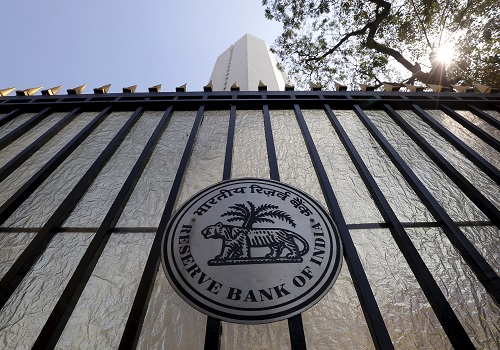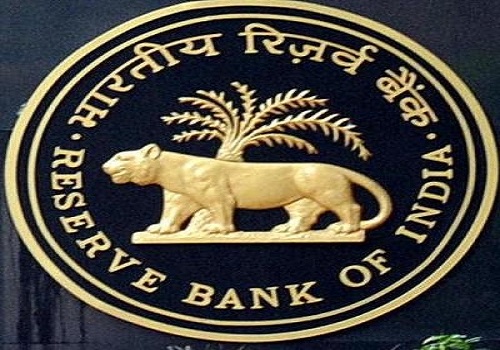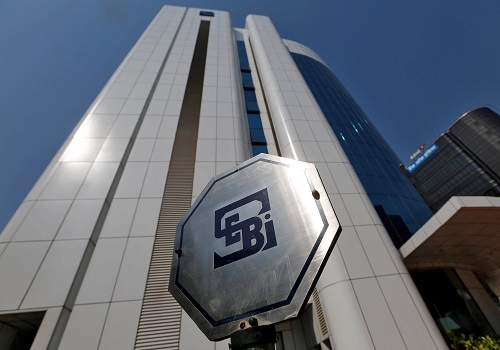Gold trading range for the day is 61590-62760 - Kedia Advisory

Follow us Now on Telegram ! Get daily 10 - 12 important updates on Business, Finance and Investment. Join our Telegram Channel
Gold experienced a decline of -0.74%, settling at 62095, influenced by a strengthening U.S. dollar and rising bond yields amidst reduced expectations for an early Federal Reserve rate cut. The market is currently anticipating a key inflation print, adding to the uncertainty. Positive employment data, including the ADP report revealing the addition of 164K jobs in December, countered by the ISM's indication of a slowdown in the services industry, has created a mixed economic landscape. Geopolitical risks and concerns about China's economic challenges continue to act as a backdrop, supporting Gold as a safe-haven asset. Traders adjusted their expectations for Fed rate cuts in 2024, lowering the projection from six to four following the release of encouraging U.S. macro data. The upcoming Nonfarm Payrolls (NFP) report, expected to show the addition of 170K jobs in December, will be closely monitored, as it could influence the Fed's policy outlook, subsequently impacting the U.S. dollar and Gold prices. From a technical perspective, the Gold market is currently undergoing long liquidation, evident in the -8.46% drop in open interest, settling at 11021. Prices have declined by -462 rupees. Support for Gold is identified at 61840, with a potential test of 61590 levels if this level is breached. On the upside, resistance is anticipated at 62425, and a move above this level could lead to a test of 62760.
Trading Ideas:
* Gold trading range for the day is 61590-62760.
* Gold prices slid due to a strong U.S. dollar and bond yields
* Reduced hopes of an early rate cut by the Federal Reserve impacted gold prices
* Markets are awaiting a key inflation print this week
Silver prices experienced a modest decline of -0.22% yesterday, closing at 72427, attributed to a broader rebound in the dollar and yields. The dollar's strength was fueled by risk aversion, with tensions escalating in the Israel-Hezbollah conflict, complicating U.S. efforts to prevent a regional crisis. Additionally, the greenback found support as U.S. Congressional leaders reached an agreement on spending levels for the fiscal year, averting a potential government shutdown. Euro zone government bond yields rose following unexpected surges in U.S. job growth in December, contributing to an overall positive economic sentiment. The Euro Area's economic sentiment indicator reached 96.4 in December 2023, the highest since May, reflecting increased confidence across all sectors despite concerns about rising inflation. Notably, the consumer confidence indicator rose to -15, the highest since February 2022, exceeding preliminary estimates. The services sentiment in the Euro Area also saw improvement, rising to 8.4 in December, the highest since April, driven by optimistic views on past and expected demand. From a technical perspective, the market is currently witnessing fresh selling momentum, indicated by a 5.63% increase in open interest to 22359, coupled with a price decline of -160 rupees. Silver is currently finding support at 71945, and a breach below this level could lead to a test of 71460. On the upside, resistance is anticipated at 72775, and a move above this level may push prices towards 73120.
Trading Ideas:
* Silver trading range for the day is 71460-73120.
* Silver ticked lower after a broad-based rebound in the dollar and yields.
* US private-sector employers added 164K jobs in December, surpassing expectations
* Data from the ISM showed a significant slowdown in the services industry
Crude oil faced a significant downturn, declining by -4.32% and settling at 5863 in response to various market factors. Saudi Arabia, the top oil exporter, implemented sharp price cuts, reducing oil prices to Asian markets to their lowest level in 27 months. This move was driven by increased competition from rival suppliers and concerns regarding a supply overhang. Saudi Aramco, the state-owned oil company, slashed the official selling price for February-loading Arab Light to Asia by $2 a barrel from January, settling at $1.50 a barrel over Oman/Dubai quotes. Simultaneously, OPEC announced an output increase of 70,000 barrels per day (bpd) in December, bringing the total to 27.88 million bpd. These combined factors contributed to the downward pressure on crude oil prices. Geopolitical tensions in the Middle East added another layer of uncertainty, with U.S. Secretary of State Antony Blinken warning about the potential for the conflict in Gaza to escalate into a broader regional conflict. Technically, the crude oil market is undergoing fresh selling pressure, evident in a 32.01% increase in open interest, settling at 17,401 contracts. With prices down by -265 rupees, crude oil is currently finding support at 5775. A breach below this level could lead to a test of 5686. On the upside, resistance is anticipated at 6025, and a move above this level might push prices toward 6186. In summary, crude oil's recent price performance is influenced by Saudi Arabia's price cuts, OPEC's output increase, and ongoing geopolitical tensions, with technical indicators pointing towards a bearish trend.
Trading Ideas:
* Crudeoil trading range for the day is 5686-6186.
* Crude oil dropped due to Saudi Arabia's sharp price cuts and OPEC's output increases.
* Saudi Arabia cut oil prices to Asian markets to their lowest level in 27 months.
* Output from OPEC rose by 70,000 barrels per day in December.
Natural gas prices experienced a marginal increase of 0.08%, settling at 236.7, driven by forecasts of mild weather and ample gas reserves. Currently, inventories are 13% above average levels, primarily due to record domestic production. Looking ahead, the market anticipates extreme cold weather in mid-to-late January, projected to elevate demand to levels not seen since the winter storm record in December 2022. While freezing conditions may lead to potential production disruptions known as freeze-offs, experts believe it's unlikely to drive prices to the peak observed on November 1st at $3.608/MMBtu. The Energy Information Administration (EIA) reported a weekly drop of 14 billion cubic feet (Bcf) in natural gas inventories for the week ending December 29, bringing the total to 3,476 billion cubic feet. On an annual basis, this figure increased by 553 Bcf, surpassing the five-year average by 399 Bcf. The current total working gas is above the five-year historical range, standing at 3,476 billion cubic feet. From a technical standpoint, the market is undergoing short-covering, indicated by a -6.59% drop in open interest, settling at 18,144 contracts. Despite a modest increase of 0.2 rupees in prices, natural gas finds support at 226.8, with a potential test of 217 if this level is breached. On the upside, resistance is expected at 243.6, and a move above this level could lead to prices testing 250.6.
Trading Ideas:
* Naturalgas trading range for the day is 217-250.6.
* Natural gas settled flat due to forecasts of mild weather and sufficient gas reserves.
* Current inventories are 13% above average levels due to record domestic production.
* Working natural gas in storage dropped by 14 Bcf in the seven days ending December 29.
Copper prices experienced a marginal decline of -0.05%, settling at 720.35, driven by factors such as a rebound in the US dollar, uncertain demand outlook, and an increase in stocks. The US dollar's strong rebound contributed to pressure on copper prices as traders revised their expectations regarding the extent of the Federal Reserve's potential policy loosening for the year. Concerns about demand were heightened by a significant drop in the official Chinese manufacturing Purchasing Managers' Index (PMI), although the broader Caixin data showed an improved expansion. Additionally, inventory data from the Shanghai Futures Exchange revealed an 8% increase in inventories in key Chinese warehouses, reaching 33,130 tonnes in the first week of January. BMI anticipates a slight improvement in copper prices in 2024. However, weak Chinese demand and a limited growth outlook across major markets could potentially cap the upside potential for prices. Chile reported an 8.14% decrease in copper exports in December, totaling $4.16 billion compared to the same period the previous year, as per the central bank's data. In terms of market dynamics, the International Copper Study Group reported a 53,000 metric tons deficit in the global refined copper market for October. World refined copper output in October stood at 2.34 million metric tons, while consumption reached 2.39 million metric tons. Technically, the market observed long liquidation, with a -0.93% drop in open interest, settling at 5746. Copper finds support at 717.9, with a potential test of 715.3. Resistance is anticipated at 722.8, and a move above could lead to testing 725.1.
Trading Ideas:
* Copper trading range for the day is 715.3-725.1.
* Copper prices dropped due to a rebound in the US dollar, uncertain demand, and an increase in stocks.
* Uncertainty over demand from key Asian customers, particularly China, due to mixed manufacturing data.
* Inventories in Chinese warehouses rose by 8% in the first week of January.
Zinc prices faced a decline of -0.89%, settling at 223.5, influenced by an increase in social inventories of zinc ingots across seven major markets in China. The data revealed a total of 81,600 mt as of January 5, marking a rise of 5,800 mt from December 29 and 2,400 mt from January 2. Notably, Shanghai experienced an uptick in inventory due to continued arrivals of imported zinc ingots. On the other hand, Guangdong witnessed a decrease in inventory due to low incoming shipments from smelters, while Tianjin's market showed normal arrivals with a significant growth in registered warehouse receipts. Despite these inventory dynamics, the downside for zinc prices appears limited. Smelters in Shaanxi, Hunan, and Yunnan halted production for overhauls, leading to significant output reductions. Additionally, output decreased from some smelters in Inner Mongolia, Shaanxi, Yunnan, and Guangdong. In contrast, Sichuan smelters increased production, and Gansu smelters concluded maintenance, contributing to growing output. In November 2023, China's refined zinc output amounted to 579,000 mt, a 4.23% month-on-month decrease but a year-on-year increase of 10.62%. The total output from January to November reached around 6.03 million mt, reflecting a 10.62% year-on-year growth. Domestic zinc alloy output in November was 93,300 mt, indicating a 4,800 mt decline from the previous month. Technically, the market witnessed long liquidation, with a -28.02% drop in open interest to settle at 2720. Zinc finds support at 222.4, with a potential test of 221.3. Resistance is anticipated at 225, and a move above could lead to testing 226.5.
Trading Ideas:
* Zinc trading range for the day is 221.3-226.5.
* Zinc dropped as social inventories of zinc ingots in China up 5,800 mt from December 29
* Inventory in Shanghai increased as imported zinc ingot continued to arrive
* Smelters in Sichuan increased production, and smelters in Gansu ended maintenance, leading to growing output
Aluminium prices experienced a decline of -0.92%, settling at 203.55, driven by increased aluminium stocks in LME-registered warehouses, reaching their highest level since June. The influx of 14,525 tons of arrivals contributed to this surge, as indicated by daily LME data. The social inventory of domestic aluminium billet also witnessed a notable increase, reaching 82,000 mt on January 4. This marked a weekly rise of 17,900 mt and a year-on-year increase of 2,300 mt, reflecting a rapid buildup post-holidays. On the macroeconomic front, the U.S. non-farm payrolls in December exceeded expectations, and the unemployment rate was lower than anticipated. Despite a slight dip in the ISM service industry index, it remained in the expansion range, underscoring job market resilience and reducing expectations for interest rate cuts. Fundamentally, the domestic aluminium supply side has entered a period of stable operation with no major short-term changes anticipated. As the traditional off-season unfolds, the industry expects an increase in aluminium ingot production. The disruptions in alumina supply caused by the oil deposit incident in Guinea and the conclusion of the domestic heating season might stabilize for the time being. This has prompted a return to fundamentals in the trading logic of SHFE aluminium. Technically, the market is under long liquidation, witnessing a -1.67% drop in open interest to settle at 4186. Aluminium finds support at 202.9, with a potential test of 202.1. Resistance is anticipated at 204.8, and a move above could lead to testing 205.9.
Trading Ideas:
* Aluminium trading range for the day is 202.1-205.9.
* Aluminium dropped as LME stocks are at their highest since June.
* The social inventory of domestic aluminium billet stood at 82,000 mt on January 4, an increase of 17,900 mt WoW
* Domestic aluminium supply side is stable with no major changes in the short term
Cotton prices, represented by Cottoncandy, saw a decline of -0.86%, settling at 55580. The drop is attributed to Brazil's record-high cotton production in the 2022-23 season, contributing to an overall increase in global cotton supply. However, the surge in supply is met with sluggish demand, influenced by challenging economic conditions globally, leading to inflated inventories and downward pressure on cotton prices. The Cotton Association of India (CAI) maintained its pressing estimate for the 2023-24 season at 294.10 lakh bales. CAI President Atul S Ganatra noted that the total supply till the end of November stood at 92.05 lakh bales, with market arrivals, imports, and opening stocks contributing to the overall estimate. Reports indicate a decline in pink bollworm infestation in the cotton crop, reducing from 30.62% during 2017-18 to 10.80% in 2022-23. This reduction in infestation is a positive factor for cotton production. Brazilian cotton shipments in November reached 253.71 thousand tons, reflecting a 12% increase compared to October 2023 but a 5.5% decrease compared to November 2022. The global scenario, as projected by the International Cotton Advisory Committee (ICAC), indicates that global cotton production is expected to outpace consumption for the second consecutive year, with a forecasted increase in production to 25.4 million metric tons in the 2023-2024 season. The U.S. cotton balance sheet for 2023/24 shows slightly lower consumption, higher production, and ending stocks. Global cotton balance sheets also reflect lower consumption, but higher production and stocks, with India's production contributing to increased beginning stocks. In the major spot market of Rajkot, Cottoncandy prices ended at 26438.85 Rupees, marking a decrease of -0.25%. Technically, the market is undergoing long liquidation, with a -1.94% drop in open interest, settling at 202. Cottoncandy is currently supported at 55360, with a potential test of 55140 below, while resistance is expected at 55860, and a move above could lead to testing 56140.
Trading Ideas:
* Cottoncandy trading range for the day is 55140-56140.
* Cotton dropped as Brazil hits record cotton production in 2022-23
* Global cotton production expected to outpace consumption for second year in a row.
* Pink bollworm infestation in cotton crop has declined.
* In Rajkot, a major spot market, the price ended at 26438.85 Rupees dropped by -0.25 percent.
Turmeric prices experienced a decline of -3.38%, settling at 12980, attributed to slower buying activities ahead of the anticipated release of stocks with the commencement of new crops in January 2024. The market also faced pressure due to improved crop conditions resulting from favorable weather. The location announcement of PM Modi's Turmeric Board in Telangana sparked concerns among farmers in Maharashtra regarding the headquarters' location. Despite such concerns, the crop condition is reported to be satisfactory, with harvest readiness expected during January to March. The current levels of buying activity and decreasing supplies are expected to sustain price stability. Export opportunities for turmeric have improved, with a 25% increase in exports, driven by increased demand in both developed and emerging nations. However, expectations of a 20–25% decline in turmeric seeding, particularly in regions like Maharashtra, Tamil Nadu, Andhra Pradesh, and Telangana, reflect shifting priorities among farmers. Turmeric exports in October 2023, turmeric exports gained by 11.58% compared to September 2023, but a 9.30% decline was observed compared to October 2022. In the major spot market of Nizamabad, Turmeric prices ended at 12945.25 Rupees, reflecting a decrease of -0.88%. Technically, the market witnessed long liquidation, with a -1.57% drop in open interest, settling at 12235. Turmeric is currently supported at 12782, with a potential test of 12584 below, while resistance is expected at 13294, and a move above could lead to testing 13608.
Trading Ideas:
* Turmeric trading range for the day is 12584-13608.
* Turmeric dropped as buying activities has been slower ahead of commencement of new crops.
* Pressure also seen amid improved crop condition due to favorable weather condition.
* Turmeric exports during Apr-Oct 2023, rose by 2.63 percent at 1,02,162.94 tonnes as compared to Apr-Oct 2022.
* In Nizamabad, a major spot market, the price ended at 12945.25 Rupees dropped by -0.88 percent.
Jeera prices took a notable dip of -3.51%, settling at 27205, primarily driven by expectations of higher production in key cultivating states like Gujarat and Rajasthan. The aggressive sowing activities in Gujarat, marked by a significant 102% increase in sown area, and a 13% rise in cumin cultivation in Rajasthan, have contributed to the bearish sentiment. Favorable weather conditions have facilitated smooth sowing operations, further supporting the outlook for higher production. Global demand for Indian jeera has declined as buyers have opted for alternative sources such as Syria and Turkey, given the comparatively higher prices in India. Export activities are expected to remain subdued due to this shift in preference and the overall seasonality of jeera exports. Despite the competitive pricing of Indian jeera in the global market, current conditions are not favoring exporters, suggesting a potential continuation of subdued export activity in the coming weeks. Jeera exports in October 2023, exports dropped by 13.39% compared to September 2023 and a substantial 46.77% compared to October 2022. In the major spot market of Unjha, Jeera prices ended at 31914.5 Rupees, reflecting a decrease of -0.56%. Technically, the market is characterized by fresh selling, with a 7.77% increase in open interest, settling at 1830. Jeera is currently supported at 26980, with a potential test of 26740 below, while resistance is expected at 27580, and a move above could lead to testing 27940.
Trading Ideas:
* Jeera trading range for the day is 26740-27940.
* Jeera prices dropped due to higher production prospects
* In Gujarat, Cumin sowing witnessed very strong growth by nearly 103% with 530,030.00 hectares against sown area of 2022
* Stockists are showing interest in buying on recent downfall in prices triggering short covering.
* In Unjha, a major spot market, the price ended at 31914.5 Rupees dropped by -0.56 percent.
Views express by all participants are for information & academic purpose only. Kindly read disclaimer before referring below views. Click Here For Disclaimer












 320-x-100_uti_gold.jpg" alt="Advertisement">
320-x-100_uti_gold.jpg" alt="Advertisement">








